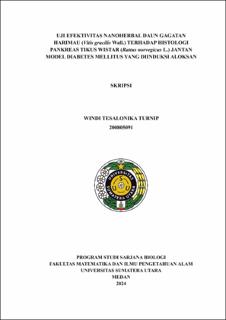Uji Efektivitas Nanoherbal Daun Gagatan Harimau (Vitis gracilis Wall.) terhadap Histologi Pankreas Tikus Wistar (Rattus norvegicus L.) Jantan Model Diabetes Mellitus yang Diinduksi Aloksan
The Effectiveness Test of Nanoherbal Gagatan Harimau Leaves (Vitis gracilis Wall.) on The Pancreatic Histology of Male Wistar Rats (Rattus norvegicus L.) in Aloksan-Induced Diabetes Mellitus Model

Date
2024Author
Turnip, Windi Tesalonika
Advisor(s)
Ilyas, Syafruddin
Metadata
Show full item recordAbstract
Gagatan harimau leaves (Vitis gracilis Wall.) are a potential anti-diabetic plant due to their secondary metabolites, including flavonoids, phenols, and gagatan harimau leaves contain secondary metabolites, including flavonoids, phenols, and tannins, which act as antioxidants. These compounds can improve organ histology and regenerate cells that have been damaged by oxidative stress, reactive oxygen species (ROS), and other free radicals. This study aims to evaluate the effectiveness of nanoherbal gagatan harimau leaves (Vitis gracilis Wall.) on the histology of the pancreas of Wistar rats (Rattus norvegicus L.) in a model of alloxan-induced diabetes mellitus. The study employed a Completely Randomized Design (CRD) with 24 rats divided into 6 treatments, each with four replications. The study involved administering various treatments, including a negative control, positive control, glibenclamide treatment at a dose of 0.45 mg/kgbw, and nanoherbal treatment for gagatan harimau leaves at doses of 100 mg/kgbw, 125 mg/kgbw, and 150 mg/kgbw. The results indicate that the administration of nanoherbal gagatan harimau leaves was effective. can reduce blood sugar levels, increase the area of the islets of Langerhans, and decrease the amount of necrosis, vacuolization, and congestion (p<0.05) in a rat model of alloxan-induced diabetes.
Collections
- Undergraduate Theses [926]
